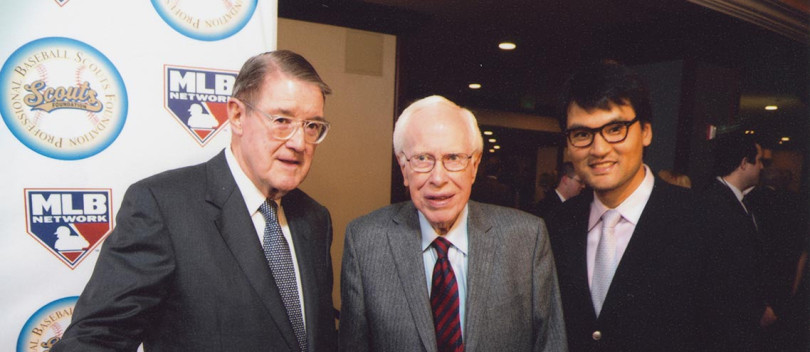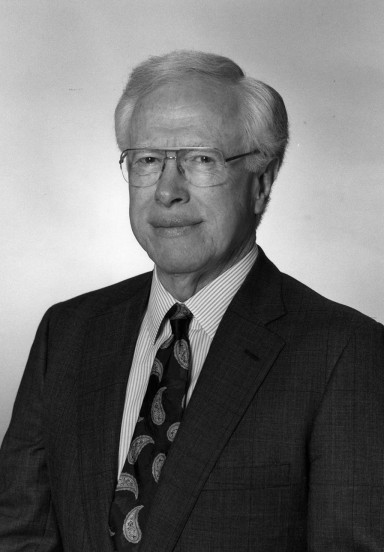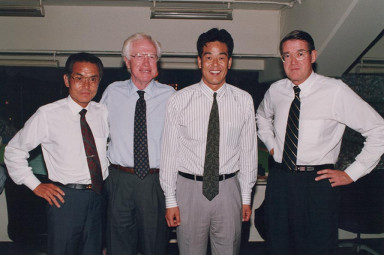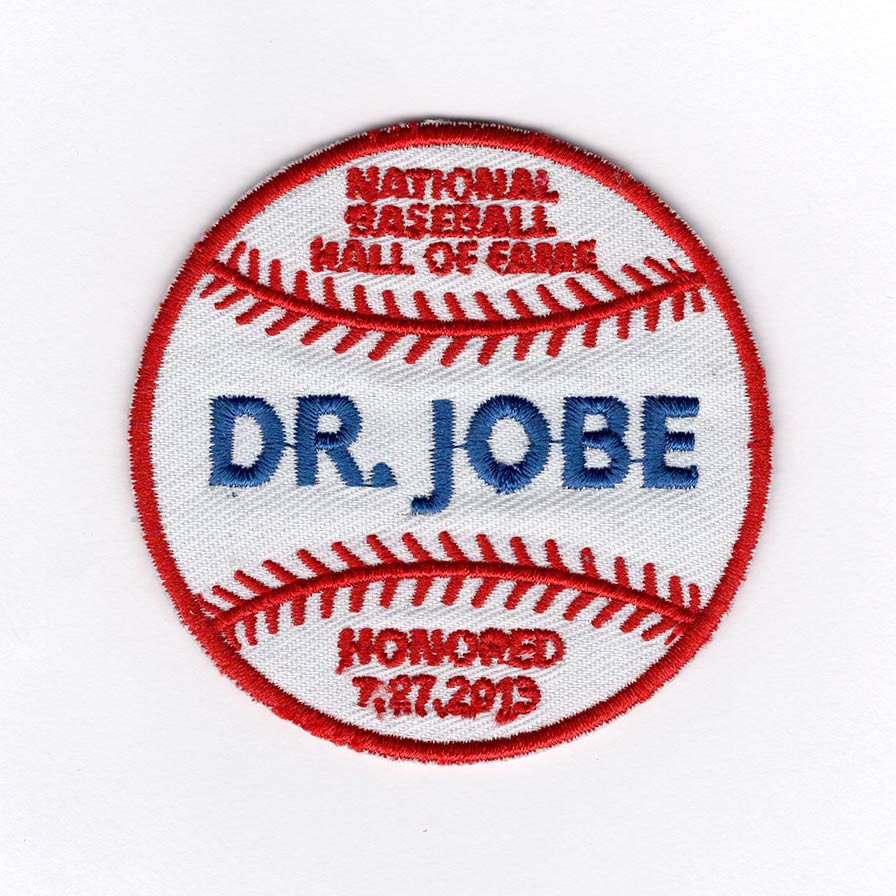
(L-R) Peter O’Malley; Dr. Frank Jobe; Chan Ho Park. Dr. Frank Jobe was considered to be sports preeminent orthopedic surgeon and served as head physician for the Dodgers. South Korean-born Chan Ho Park is the all-time winningest Asian pitcher in major league history with 124 victories. Photo at the January 14, 2012 Professional Baseball Scouts Foundation Dinner at the Beverly Hilton Hotel.
Feature
Jobe’s Patience and the Patients of Jobe
By Brent Shyer
The friendship of the O’Malley family extended not only through baseball exchanges, but also medical personnel. One of the nation’s foremost orthopaedic surgeons, Dr. Frank Jobe, saved and extended the careers of many players from Japan and other countries, just as he did in the United States.
Dr. Jobe started as a consultant to the Los Angeles Dodgers in 1964 and became their orthopaedic physician for 40 years (1968-2008). He worked closely with Dr. Robert Kerlan, who helped the Dodgers from their 1958 Los Angeles arrival, and team physician Dr. Bob Woods, one of the first hires in Los Angeles by Walter O’Malley. Mayo Alumnus magazine, October 1973, Profile on Bob Woods The O’Malleys were always thankful to have Dr. Jobe as part of the team. He worked hand-in-hand with highly respected Dodger athletic trainers like Bill Buhler who was with the ballclub from 1960-1995, Wayne Anderson, Paul Padilla, and Charlie Strasser to provide expert advice and care for the organization.
Dr. Jobe is revered as inventor of the “Tommy John Surgery”. While now ubiquitous for pitchers to undergo such surgery, at the time it was performed on 31-year-old Dodger pitcher Tommy John on September 25, 1974 not even Dr. Jobe knew what the long-term effects would be, or if John would be able to pitch effectively once again.
The odds were long. Dr. Jobe warned John not to expect much if the procedure were performed: “I told him it was only about a 1-in-100 chance it would work.” But John’s response was optimistic: “I told him a 1-in-100 chance is better than no chance at all. And without the surgery, I've got no chance." Stephania Bell, ESPN.com, “Baseball’s medical revolutionary”, July 29, 2013 In 1989, Dr. Jobe admitted, “That was a wild guess. I didn’t have any idea what the chances were.” Valerie Nelson, Los Angeles Times, Dr. Frank Jobe obituary, March 7, 2014
They went forward. Following the surgery and more than a year of rehabilitation, John returned to pitch on April 16, 1976. Amazingly, he went on to post more victories (164) in his stellar career after the surgery than he did before it (124). As Dr. Jobe taught the revolutionary procedure to other orthopaedic surgeons, it was used more routinely and elongated the careers of hundreds of pitchers. Prior to that, a torn ulnar collateral ligament signaled the end of a pitcher’s career. The delicate procedure involved taking a tendon from another part of the pitcher’s body and reconstructing the ligament in the pitcher’s arm.
In 1981, a 25-year-old undrafted pitcher named Tom Candiotti was on the Milwaukee Brewers’ 40-man roster, but he went to Dr. Jobe in search of a new elbow ligament. Following John’s surgery, seven more pitchers had undergone the same procedure, but none of them threw in the majors. Candiotti had the surgery and worked hard to rehabilitate using “hand grips, flattened tennis balls, rubber bands and using an archaic arm machine” to Bob Nightengale, USA Today Sports Weekly, ”What about Tom Candiotti surgery?”, June 6-14, 2022 strengthen his arm. It was a success and Candiotti became a prominent knuckleball pitcher and enjoyed a 16-year career (1983-1999) winning 151 games. He pitched for the Dodgers from 1992-1997 and picked up 52 wins. Candiotti, who had 68 career complete games, gave momentum for additional surgeries by Dr. Jobe.

Dr. Frank Jobe was the Dodgers’ orthopaedic surgeon for 40 years (1968-2008) and is revered in the sports medicine industry as inventor of the “Tommy John Surgery”.
With a thirst for knowledge about the surgery wherever baseball was played, other doctors reached out to learn from Dr. Jobe and he assisted by teaching many orthopaedic surgeons how to perform the “Tommy John Surgery.” But initially, that did not stop players from going directly to the man who started it all. In Japan, Hall of Fame pitcher Choji Murata of the Lotte Orions praised Dr. Jobe for giving his career new life.
Murata injured his elbow in 1982 and the next year became Dr. Jobe’s first pitcher from Japan to undergo the operation at age 33. After the surgery, Murata came back to pitch late in the 1984 season and went 17-5 in 1985. He pitched until he was 40 and had a winning post-surgery record of 59-50. Overall, Murata won 215 games in 22 seasons.
Murata recalled in The Japan Times, “At that time, elbow surgery was taboo (in Japan). In Japan, it was said a comeback was impossible, but Dr. Jobe made the impossible possible. He is the one who restored my energy to live.” The Japan Times, “Hall of Fame pitcher Murata pays tribute to Dr. Jobe”, March 7, 2014

(L-R): Akihiro “Ike” Ikuhara; Dr. Frank Jobe; Choji Murata; Dodger President Peter O’Malley at President’s Box, Dodger Stadium, Los Angeles. On July 5, 1991, Peter O’Malley welcomes Japan’s Choji Murata, a professional baseball pitcher with the Tokyo Orions/Lotte Orions from 1968-1990. Murata was inducted into the Japan Baseball Hall of Fame in 2005. Murata was the first pitcher from Japan to have Dr. Jobe perform “Tommy John Surgery.” Murata was a three-time ERA champion in Japan’s Pacific League and had 215 wins in his career.
Following Murata, many players from Japan underwent the same procedure. But it was only through Dr. Jobe’s generous time and efforts to instruct physicians in Japan, where he became a celebrity. As in the U.S., he made a significant impact in Japan in the fields of sports medicine and baseball. Dr. Jobe received an honorary doctoral degree from the University of Tokushima in 1998, in recognition of his groundbreaking work in the field and willingness to help others by sharing his expertise.
“It left a message to the next generation of players that there was no need to fear surgery,” Murata told The Japan Times in 2014, upon Dr. Jobe’s passing at age 88. Ibid. At the time of his passing, more than 1,000 Major League Baseball players, mostly pitchers, had undergone the Tommy John surgery. Valerie Nelson, Los Angeles Times, Dr. Frank Jobe obituary, March 7, 2014
The National Baseball Hall of Fame honored Dr. Jobe on July 27, 2013, as part of its Induction Weekend, with ceremonies at Doubleday Field, Cooperstown, NY. He was recognized for his significant impact in baseball by prolonging the careers of 124 Major League Baseball pitchers through the surgery he pioneered. They also honored John and the two appeared together on stage.
Colleagues and friends went to Cooperstown, New York from around the world to attend the Hall of Fame ceremonies honoring and celebrating Dr. Jobe.
Peter O’Malley said, “Frank Jobe has the respect and admiration of everyone in the Dodger organization. His reputation is impeccable, and athletes from all over the world come to see him for advice as well as surgery. Thanks to Frank, the Dodgers medical department became the gold standard and we are very happy for Frank and his family for the well-deserved recognition by the Baseball Hall of Fame.” La Sierra blog, 2014
ESPN reported: “Generations of surgeons who trained under Jobe, along with other sports medicine colleagues and research collaborators, traveled from around the world to show their admiration for a man whose influence, they believe, transcended the realm of sports medicine into simply the realm of sports. Among them were team physicians for professional and college baseball, football and basketball organizations along with others who treat recreational, high school and youth athletes.
“Dr. Teruhisa Mihata, a shoulder and elbow surgeon who also conducts biomechanical studies, traveled from Osaka, Japan, to honor the mentor he has studied with for 10 years in the States…Former Dodgers pitcher Chan Ho Park (of South Korea) was present to see his former team physician recognized.
“The gathering of Jobe supporters in Cooperstown was a reflection of how many he has touched in the worlds of sports and medicine. Considering the term ‘sports medicine’ was just coming into use around the time of John’s 1974 surgery, the trajectory of Jobe’s now-famous procedure has followed that of modern sports medicine; remote concepts once associated only with elite athletes are now increasingly familiar to athletes of all ages and skill levels.” Stephania Bell, ESPN.com, “Baseball’s medical revolutionary”, July 29, 2013

On July 27, 2013, Dr. Frank W. Jobe was honored by the National Baseball Hall of Fame in a ceremony at Doubleday Field, Cooperstown, NY for his pioneering role in sports medicine. He was first to perform and name “Tommy John Surgery”. This special patch was created for the celebration of his significant achievements.
Born in Greensboro, North Carolina, Dr. Jobe was the only child of Lacey and Alma Jobe. He grew up on the family’s small farm and attended Seventh-day Adventist boarding school in Tennessee. Jan Allen Quevedo, Frank Jobe bio, SABR.org After high school, he served as an 18-year-old medical supply sergeant for the 101st Airborne’s 326th Medical Company during World War II. He received the Bronze Star as he saw action in the Netherlands during Operation Market Garden and then in Bastogne, Belgium during the brutal Battle of the Bulge. His observation of brave physicians treating the wounded (“these guys would be operating in tents with bullets and shrapnel flying around” Richard Goldstein, New York Times, March 6, 2014 ) heightened his interest in pursuing a career in medicine upon his return home.
First, he attended his freshman year at Southern Missionary College in Tennessee, but then transferred to La Sierra College (Riverside, California), where he graduated with a Bachelor of Arts degree in 1949. It was at Loma Linda University where he received his medical degree in 1956. Later, he had a brief general practice and then completed his residency in orthopaedics at Los Angeles County Hospital. He married Beverly Anderson and they had four sons.
In 1964, Dr. Jobe and Dr. Kerlan co-founded the Kerlan-Jobe Orthopaedic Clinic, which served many sports and gained international fame. Dr. Kerlan already had a history of helping the Dodgers, as he and his friend Dr. Woods connected with Walter O’Malley as the first team doctors when the Dodgers initially arrived in Los Angeles in 1958. In fact, it was Dr. Kerlan, considered a pioneer in the sports medicine field, who diagnosed the great pitcher Sandy Koufax with traumatic arthritis in his left elbow. Dr. Kerlan was so in demand, he became team physician for the other Los Angeles-area teams, including the Rams, the Lakers and the Kings.
As a mentor, Dr. Jobe established one of the nation’s first sports medicine fellowships. Hundreds of doctors were trained by Dr. Jobe and his partners in that renowned program and many ended up abroad. Dr. Jobe also founded and was medical director of the Biomechanics Laboratory at Centinela Hospital Medical Center in Los Angeles. As a pioneer in the field, one of his goals was to prevent athletes from becoming injured in the first place and he specialized in developing exercises to do just that, in addition to the study of body motion and how it relates to sports injuries. In 1981, Dr. Michael Mellman was invited to join the Kerlan-Jobe Orthopaedic Clinic following his residency at Cedars-Sinai, Los Angeles. Dr. Mellman went on to become Dodger team physician in 1986 and worked closely with Dr. Jobe.
Dr. James Andrews, also of sports medicine fame, noted: "His leadership has been instrumental not only in the development of the Kerlan-Jobe clinic and baseball physicians in the United States, but also for expanding baseball medicine overseas, particularly in Japan and Korea." Ibid.
In Korea, Heo Koo-Yeon learned firsthand from Dr. Jobe a very important lesson.
“Admittedly, I didn’t know at the time how famed (Dr. Jobe) was,” Heo said. Ibid.
Heo has been a baseball commentator for nearly 40 years and advisor to the Commissioner of the Korean Baseball Organization (KBO). In 1984, Dodger President Peter O’Malley invited Heo to Dodgertown, Vero Beach, Florida to observe and experience the Dodgers’ spring training camp.
“That, in the big picture, changed and influenced my life,” Heo said. “It also influenced Korean baseball a lot. I would say it was the turning point of our nation’s baseball. O’Malley enthusiastically told me to come over and he treated me well.” Sung Min Kim, blogs.fangraphs.com, “How One Man Changed Korean Baseball”, June 14, 2019
According to Heo, O’Malley told his executives and coaches, “Let Mr. Heo do whatever he wants at camp. He has no limitations.” Ibid.
Heo recalls being with Dodger Manager Tommy Lasorda and General Manager Al Campanis at practices and games.
He also witnessed Dodger star pitcher Fernando Valenzuela icing his arm after throwing, a process that Heo was unfamiliar with. He met Dr. Jobe and was interested in the icing procedure, since it was just the opposite of what was being practiced in South Korea.
He asked Dr. Jobe, “Why is (Valenzuela) icing his arm? In Korea, we have pitchers take a hot bath after throwing.” Ibid.
Dr. Jobe’s response to that was that’s “no way to treat an arm.” Ibid.
Heo recalls, “That really surprised me. So after I came to Korea, I felt the urgency to let others know about it through television. In one of the games I commentated, I said, ‘As I learned in the United States, pitchers should ice their arms after throwing. If they go into hot water, it leads to counterproductive results.’” Ibid. Although many were initially skeptical with the advice, Heo did help change the culture and the post-throwing routine for pitchers.
In March, 2022, Heo was unanimously named Baseball Commissioner of the KBO by its member clubs.
In September, 1993, prior to the 1994 signing of right-handed pitcher Chan Ho Park, the first South Korea-born player in Major League Baseball, Peter O’Malley traveled with Dr. Jobe to meet with Park and his parents in Korea. Dr. Jobe examined Park and though he determined he was very sound overall, he had “a slight overgrowth of bone in his pitching elbow.” Maryann Hudson, Los Angeles Times, March 18, 1994 Though not uncommon, it indicated to Dr. Jobe that Park might have developed it from overuse, as it typically did not show up in pitchers until later in their careers. “It doesn’t mean that something is wrong, but we need to have him under a good pitching program that doesn’t allow him to hurt his elbow,” Jobe said as Park launched his Dodger career. Ibid. Pioneer Park went on to win 124 games in the majors, the most by any pitcher from Asia, and had an impressive 17-year career, including 9 seasons with the Dodgers.
In 1994, as part of the Professional Baseball Athletic Trainers Society International Program, Dodger trainer Strasser went to Japan with longtime Seattle Mariners head athletic trainer Rick Griffin “to establish an exchange program with Japanese athletic trainers. A program was then established that allowed students from Japan to come and work with athletic trainers in spring training each year.” Pbats.com, “PBATS International Program Success,” 2021
Humble and quick-witted, Dr. Jobe authored seven books and was published in more than 140 medical publications. He once said of the famous Tommy John surgery: “I did a little bit of surgery, but he [John] did all the hard work.” Ibid.
It was Dr. Jobe who informed Dodger outfielder Kirk Gibson that he would not be able to play in Game 1 of the 1988 World Series. La Sierra blog, 2014 Both of Gibson’s legs were badly injured and it did not seem physically possible for him to play on October 15, 1988 at Dodger Stadium. Gibson recalls, “I was hurting pretty bad. I had a torn hamstring tendon in my left leg and a strained medial collateral ligament in my right leg. I hurt my hamstring in Game 5 [of the NLCS] against the Mets and got a shot right after that game from Dr. [Frank] Jobe. I didn’t play in Game 6, but I did play in Game 7. Then I went to break up a double play and I slid funky because of my other leg, and that’s when I stretched my medial collateral.” SI.com, October 15, 2013
In the third inning of Game 1 of the World Series, Gibson told his wife JoAnn to take their active two-year-old son home because Kirk wasn’t going to play. Ibid.
But a determined Gibson overcame the pain from the injuries to give the Dodgers a shot in the arm with two out in the bottom of the ninth inning, trailing 4-3 and Dennis Eckersley on the mound for the Oakland Athletics. He told the New York Times, “Why go up to the plate if you don’t believe you can do it? That’s the way I picture myself. I think about doing that type of thing, being up there in that situation.” Murray Chass, New York Times, February 24, 1989
Of course, Gibson surprised everybody and the world knows the results. How Gibson convinced Dodger Manager Tommy Lasorda to let him pinch-hit and hobbled up to home plate, worked the count to 3-2 with Mike Davis on base and then proceeded to hit the most dramatic home run in Dodger history to win Game 1, 5-4. Dr. Jobe told reporters that under normal circumstances Gibson would be sidelined for two weeks. Deseret News, deseret.com, October 18, 1988 Game 1 was his only appearance in the World Series. Gibson’s home run was voted the “Greatest Moment in Los Angeles Sports History” and is always listed among baseball’s greatest all-time home runs.
Dr. Jobe also is credited with performing groundbreaking major reconstructive shoulder surgery on Dodger star pitcher Orel Hershiser in 1990. This was the first time the procedure was used on a major league player. Dr. Jobe’s innovative surgery, which was designed to lessen trauma to tissue during the operation, enabled Hershiser to continue pitching for 10 seasons following the surgery. The Dodger right-hander and 1988 World Series MVP earned more wins (105) after the surgery than he had prior to it. Dr. Jobe’s method of surgery is still used to this day.
A patient and compassionate Jobe always tried to provide encouragement to the players. Hershiser said at the time of Dr. Jobe’s 2014 passing, “He was not only our doctor, he was our friend.” Eric Stephen, truebluela.com, March 7, 2014
Hershiser also tweeted, “Dr. Jobe not only put us back together. He also had the greatest bed-side manner! Time to calm a young man’s fears about his future!! Dr. Jobe may have touched more wins and saves than anyone in baseball. He changed my life!! Gave me back my career.” Bill Plunkett, Orange County Register, March 6, 2014
Providing injured pitchers with a way to get back to the mound had a profound effect on Dr. Jobe, who once told Major League Baseball’s website, “Sometimes it just makes you want to cry watching those guys go on to great things. It really does.” Richard Goldstein, New York Times, March 6, 2014
All of baseball around the world owes Dr. Frank Jobe a debt of gratitude for his life of service and innovation.

